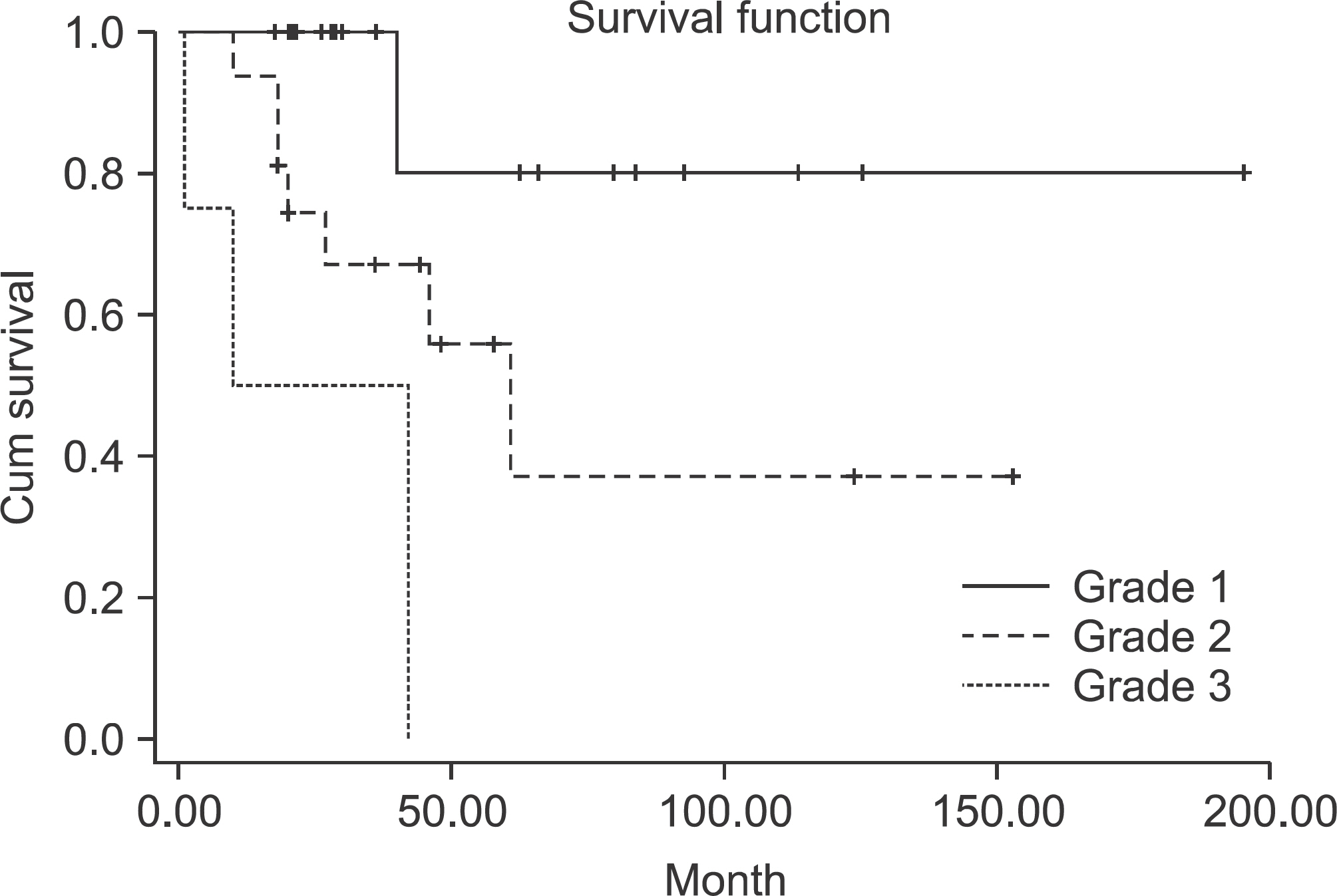J Korean Bone Joint Tumor Soc.
2013 Jun;19(1):9-13. 10.5292/jkbjts.2013.19.1.9.
Oncologic Outcome of Chondrosarcomas
- Affiliations
-
- 1Department of Orthopedic Surgery, Seoul St. Mary's Hospital, College of Medicine, The Catholic University of Korea, Seoul, Korea. ygchang@catholic.ac.kr
- 2Department of Orthopedic Surgery, Yoido St. Mary's Hospital, College of Medicine, The Catholic University of Korea, Seoul, Korea.
- 3Department of Orthopedic Surgery, St.Vincent Hospital, College of Medicine, The Catholic University of Korea, Seoul, Korea.
- 4Department of Orthopedic Surgery, Uijeongbu St. Mary's Hospital, College of Medicine, The Catholic University of Korea, Seoul, Korea.
- KMID: 1431654
- DOI: http://doi.org/10.5292/jkbjts.2013.19.1.9
Abstract
- PURPOSE
We evaluated oncologic outcomes of chondrosarcomas and analyzed the disease-free survival rate of chondrosarcomas according to the various factors.
MATERIALS AND METHODS
We performed a retrospective study for the disease-free survival rate of 48 chondrosarcomas, 44 of which underwent surgical treatment and followed up more than 18 months since 1993, and in the remaining 4 cases, the patients died before 18 months after surgery. The vsariables were location, tumor volume, histologic grade, stage, age at presentation and treatment performed. The mean follow up period was 43.8 months (1-196 months).
RESULTS
The overall disease-free survival rate was 77.1% at mean 43.8 month follow up. The 5 year- and 10 year disease-free survival rates were 64% and 58% respectively. The histologic grade, stage, age at presentation revealed statistical significance on disease-free survival. All 9 patients treated with extended curettage for grade 1 central chondrosarcomas revealed disease-free survival with excellent functional outcome.
CONCLUSION
The disease-free survival rate of chondrosarcomas mainly depended on histologic grade, stage and age at presentation. Local recurrence and distant metastasis also revealed statistically significant differences of disease-free survival rate. Comparing to wide resection, extended curettage for low-grade central chondrosarcomas in extremities were efficient methods with similar survival rate and less functional losses and complications.
MeSH Terms
Figure
Reference
-
References
1. Ahmed AR, Tan TS, Unni KK, Collins MS, Wenger DE, Sim FH. Secondary chondrosarcoma in osteochondroma: report of 107 patients. Clin Orthop Relat Res. 2003; 411:193–206.
Article2. Lee FY, Mankin HJ, Fondren G, et al. Chondrosarcoma of bone: an assessment of outcome. J Bone Joint Surg Am. 1999; 81:326–38.3. Pritchard DJ, Lunke RJ, Taylor WF, Dahlin DC, Medley BE. Chondrosarcoma: a clinicopathologic and statistical analysis. Cancer. 1980; 45:149–57.
Article4. Healey JH, Lane JM. Chondrosarcoma. Clin Orthop Relat Res. 1986; 204:119–29.
Article5. Enneking WF, Dunham W, Gebhardt MC, Malawar M, Pritchard DJ. A system for the functional evaluation of reconstructive procedures after surgical treatment of tumors of the musculoskeletal system. Clin Orthop Relat Res. 1993; 286:241–6.
Article6. Dahlin DC, Henderson ED. Chondrosarcoma, a surgical and pathological problem; review of 212 cases. J Bone Joint Surg Am. 1956; 38-A:1025–38.7. Kaufman JH, Douglass HO Jr, Blake W, Moore R, Rao UN. The importance of initial presentation and treatment upon the survival of patients with chondrosarcoma. Surg Gynecol Obstet. 1977; 145:357–63.8. Evans HL, Ayala AG, Romsdahl MM. Prognostic factors in chondrosarcoma of bone: a clinicopathologic analysis with emphasis on histologic grading. Cancer. 1977; 40:818–31.9. Bruns J, Elbracht M, Niggemeyer O. Chondrosarcoma of bone: an oncological and functional follow-up study. Ann Oncol. 2001; 12:859–64.
Article10. Murphey MD, Walker EA, Wilson AJ, Kransdorf MJ, Temple HT, Gannon FH. From the archives of the AFIP: imaging of primary chondrosarcoma: radiologic-pathologic correlation. Radiographics. 2003; 23:1245–78.11. Ryzewicz M, Manaster BJ, Naar E, Lindeque B. Low-grade cartilage tumors: diagnosis and treatment. Orthopedics. 2007; 30:35–46.12. Alho A, Skjeldal S, Melvik JE, Pettersen EO, Larsen TE. The clinical importance of DNA synthesis and aneuploidy in bone and soft tissue tumours. Anticancer Res. 1993; 13:2383–7.13. Weiner SD. Enchondroma and chondrosarcoma of bone: clinical, radiologic, and histologic differentiation. Instr Course Lect. 2004; 53:645–9.14. Ozaki T, Hillmann A, Lindner N, Blasius S, Winkelmann W. Chondrosarcoma of the pelvis. Clin Orthop Relat Res. 1997; 337:226–39.
Article15. Ahlmann ER, Menendez LR, Fedenko AN, Learch T. Influence of cryosurgery on treatment outcome of low-grade chondrosarcoma. Clin Orthop Relat Res. 2006; 451:201–7.
Article16. Normand AN, Cannon CP, Lewis VO, Lin PP, Yasko AW. Curettage of biopsy-diagnosed grade 1 periacetabular chondrosarcoma. Clin Orthop Relat Res. 2007; 459:146–9.
Article17. Schreuder HW, Pruszczynski M, Veth RP, Lemmens JA. Treatment of benign and low-grade malignant intramedullary chondroid tumours with curettage and cryosurgery. Eur J Surg Oncol. 1998; 24:120–6.
- Full Text Links
- Actions
-
Cited
- CITED
-
- Close
- Share
- Similar articles
-
- Chondrosarcoma: MR Imaging Findings Correlated with Pathologic Classification and Grade
- The Expressions of Hypoxia-Inducible Factor-1 and Vascular Endothelial Growth Factor in Osteosarcoma and Chondrosarcoma
- Head and Neck Oncologic Care During the COVID-19 Pandemic
- Chondrosarcoma of the Skull Base ; Report of Three Cases
- Current Status of Laparoscopic Surgery for Colorectal Cancer



